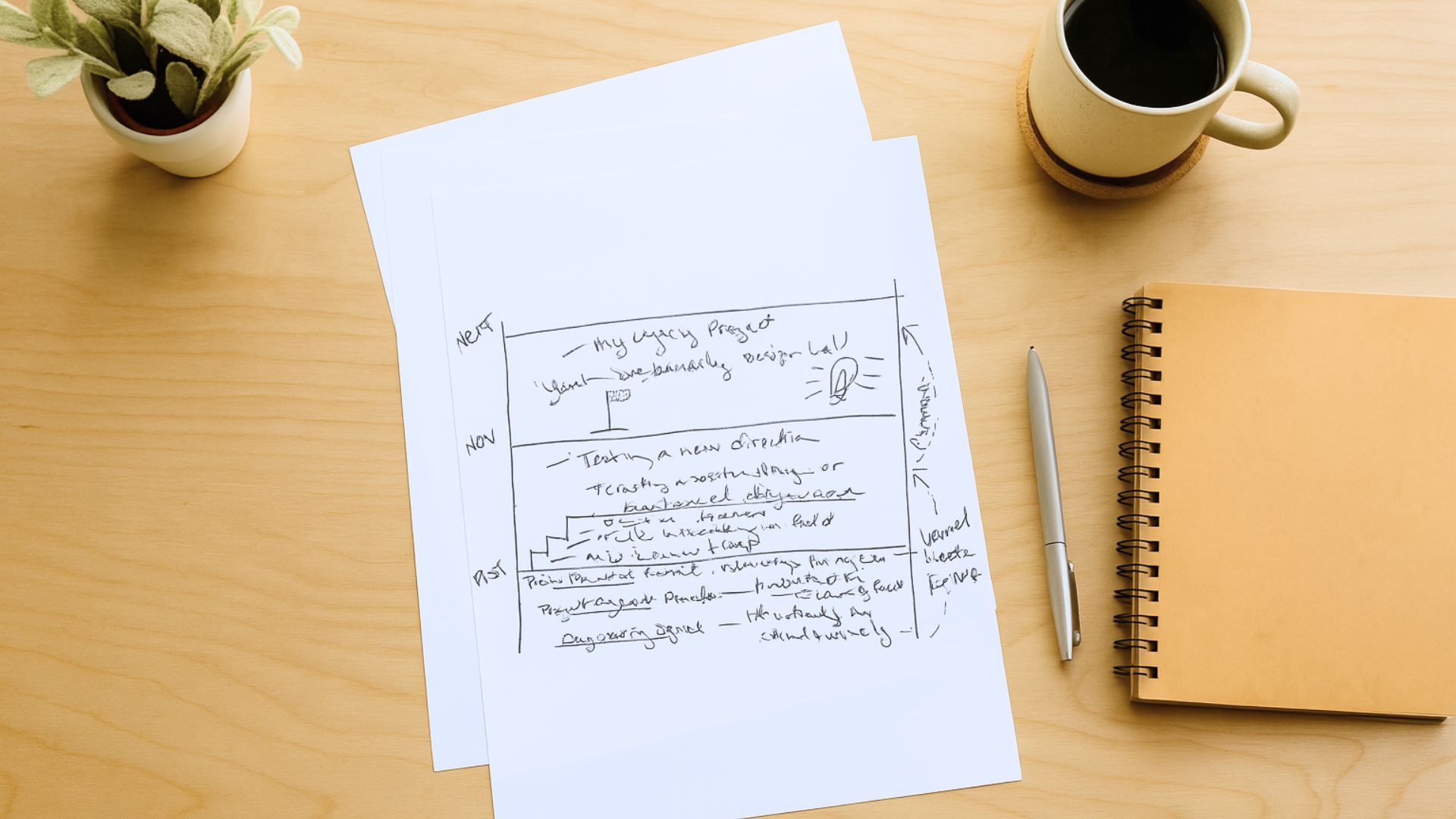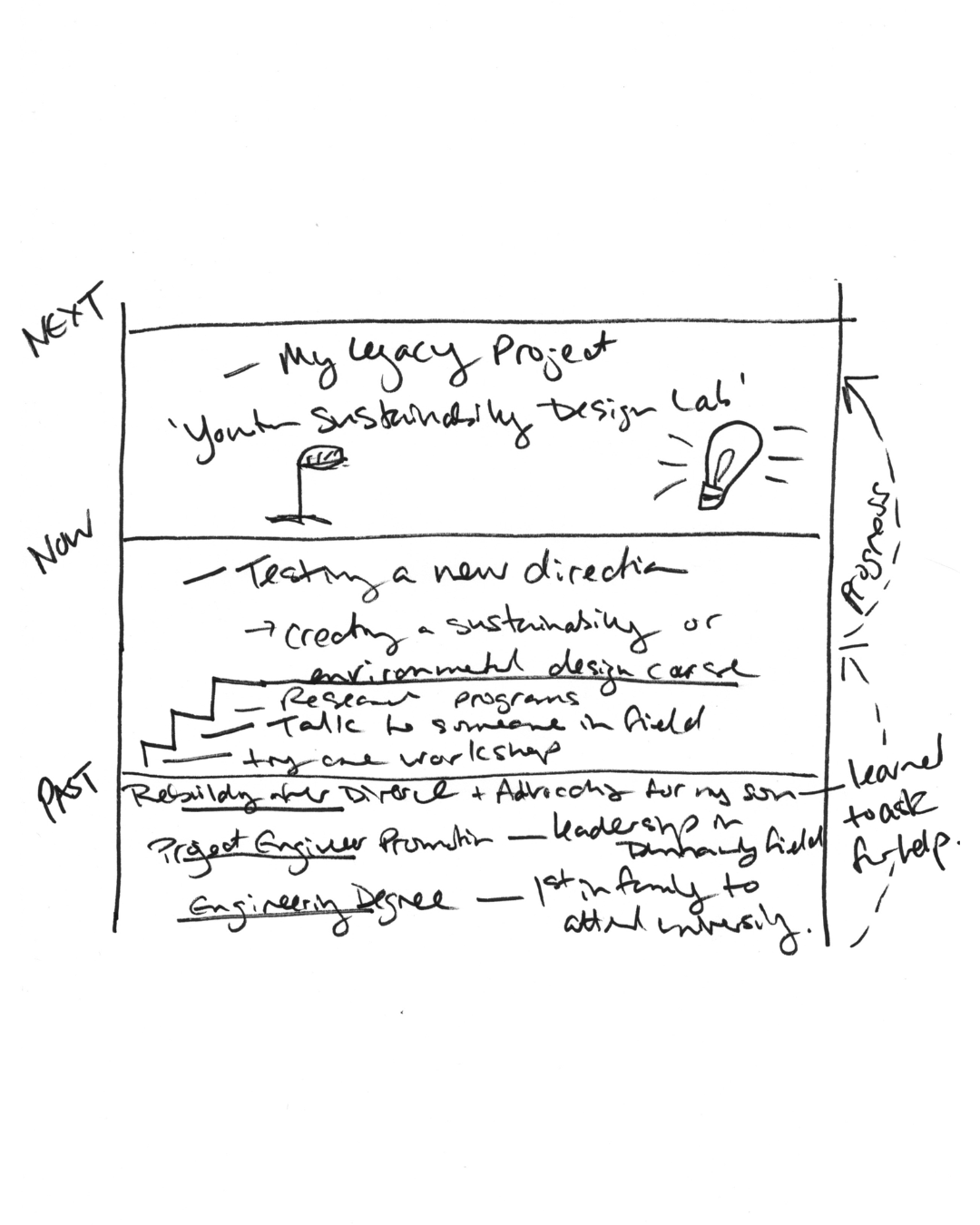Drawing Your Way Forward: How One Client Reclaimed Her Career Direction

When Gabriela first arrived in my (virtual) coaching space, she was doing what so many mid-career women in STEM quietly do: holding everything together, while quietly wondering what happened to the spark.
She had led multimillion-dollar infrastructure projects, rebuilt life after divorce, advocated fiercely for her child’s needs, and earned respect in a male-dominated engineering field. On paper, Gabriela had every reason to feel confident. But inside, she felt like she was circling the same track—efficient, reliable, and increasingly disconnected from herself.
What she really wanted was something different. Not louder, not flashier—just more her. She was drawn to sustainability, education, and design. But the leap from engineering into something more creative felt massive. Too massive, perhaps.
So we drew it out.
The Visual Tool That Changed the Conversation
We used a coaching framework called Raise the Bar, a simple drawing of a high jump stand that becomes a metaphor for progress, growth, and inner permission.
At first glance, it’s just two vertical lines and a few horizontal bars.
But on paper, it became a space where Gabriela could reconnect with what she’s already overcome, name the challenge in front of her, and begin imagining something bold that lives beyond the next checkbox.
Step 1: Seeing the Past Differently
We began by drawing the lowest bars first—the goals and challenges Gabriela had already “jumped.”
She named her engineering degree. Her promotion to project lead. Navigating the end of her marriage. Advocating for her son after his ADHD diagnosis. Each moment got its own bar.
And with each bar, she remembered not just what she had done, but how. She described persistence. Grit. Learning to ask for help.
She paused, looking at the drawing.
“I’ve been so focused on where I’m not,” she said, “that I forgot how far I’ve come.”
That’s the quiet power of drawing in coaching. We step out of the swirl of thoughts and into something visual, something grounded. The brain processes images differently than words. When we sketch a metaphor, we activate both the logical and emotional parts of the brain—what researchers call dual coding. It improves memory, clarity, and most importantly, insight.
Step 2: Naming What’s Next
With her past clearly marked on the page, we moved to the middle bar: her next challenge.
Gabriela wanted to explore sustainability and creative problem-solving. She was curious about taking a design course but hesitant. She didn’t want to “start over,” and she worried about being indulgent.
We labeled the next bar Testing a New Direction. Together, we mapped out warm-up jumps: researching courses, talking to someone in the field, attending one workshop.
For the first time, it wasn’t just a vague “maybe someday.” It was a bar she could approach, with steps and structure—but without pressure. A visual anchor turned her curiosity into a possibility.
Step 3: Imagining the Highest Jump
Then came the final bar—the highest point on the stand.
I asked her, “If nothing were off the table, what would you aim for?”
She hesitated. Then, softly, she said, “I’ve had this idea of a youth sustainability lab. A place where kids build real-world projects. Something messy, creative, hands-on. I don’t know what it looks like exactly—but it lights me up.”
We labeled it My Legacy Project.
She smiled. “This is the first time I’ve said it out loud.”
That’s the moment I love most. When a client gives language—and form—to something they’ve only held quietly inside.

Why Drawing Helps So Much
Gabriela’s session wasn’t about solving everything in 60 minutes. It was about creating space—to reflect, visualize, and reconnect with a sense of agency.
Drawing tools in coaching aren't about being artistic. They’re about shifting perspective. When we sketch ideas, we:
- Externalize internal noise, so we can look at it more objectively
- Reframe our achievements, moving from “that’s just what I had to do” to “I’m proud of this”
- Activate visual-spatial reasoning, which helps us imagine options and think creatively
- Engage with metaphors, which research shows can reduce defensiveness and deepen emotional processing
A 2020 study in Coaching: An International Journal of Theory, Research and Practice found that visual metaphors in coaching sessions helped clients increase self-awareness and identify new paths forward more effectively than verbal discussion alone.
In Gabriela’s case, the drawing gave her a way to hold her past, present, and future all in one frame—without judgment. Just space.
What Happens Next
At the end of our session, I asked her, “What do you see now, when you look at the whole stand?”
She said, “That I’ve already done hard things. And those things… weren’t detours. They were training.”
That’s the kind of shift that opens doors.
Gabriela didn’t need a total reinvention. She just needed a moment of clarity—and a visual framework that helped her see her story differently.
A Gentle Invitation
If you’re a woman in STEM wondering what’s next, you don’t need to map your entire future today.
But you might want to sketch a bar or two.
What have you already cleared that deserves more credit?
What’s the next small jump that feels worth preparing for?
And if you let yourself imagine something higher… what might it be?
You can start simple. You don’t need markers or a fancy diagram. Just two lines, and space to reflect.
And if you’d like a little guidance with that process, I’d be honoured to support you.
Ready to try it for yourself?
Join the 5-Day Creative Reset Challenge for gentle prompts that help you reflect, reset, and reconnect with what matters.
Or sign up for The Creative Shift, my weekly newsletter filled with coaching tools and creative wellness insights—designed for women who are ready to move forward without burning out.